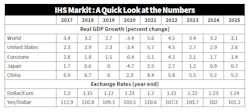Latest from Market Sales Estimates
Electrician Employment - 2023 MSA Level
Top Small Counties to Watch in 2025
Electrical Product Mix Estimates
IHS Markit Lowers U.S. GDP Growth Forecast to a Still-Strong +5.7% in 2021
In the IHS Sept. 2021 World Flash, Sara Johnson, executive director, Global Economics, said her firm has downwardly revised its global GDP growth forecast to +5.6% in 2021 because of uneven global economic expansion amid consumer caution and supply constraints. Following is her analysis of the latest IHS global market growth data, which is available exclusively to subscribers of Electrical Marketing newsletter.
The global economic expansion lost momentum in the third quarter of 2021, as new waves of the COVID-19 virus dampened consumer sentiment and idled production. With new COVID-19 cases now falling and vaccinations rising in most regions, global growth is set to strengthen to a +5% to +6% annual rate in late 2021 and early 2022, led by a strong rebound in Asia Pacific. Growth will pick up across the Americas but moderate from exceptional mid-2021 rates in Western Europe.
Over the course of 2022, global real GDP growth will downshift from the above-trend rates that are characteristic of the early stages of an expansion to more sustainable rates near +3%. The withdrawal of massive fiscal stimuli deployed during the pandemic will contribute to this deceleration. Globally, government deficits are projected to narrow from 9.4% of GDP in 2020 to 6.4% of GDP this year and 3.8% of GDP in 2022. Inflationary pressures will dampen spending on supply-constrained products and contribute to increases in long-term interest rates.
After a -3.4% decline in 2020, world real GDP is projected to increase +5.6% in 2021 and +4.5% in 2022, led by strong recoveries in consumer spending and business investment. This month’s forecast of global growth has been revised downward by -0.1% this year, owing to a weaker third-quarter performance in the United States. Global growth will settle to +3.4% in 2023 and +3.2% in 2024 as pent-up demands are satisfied and major economies return to full employment.
The thinking behind IHS’ revised U.S. forecast.
COVID-19 concerns and supply issues shift US growth from 2021 to 2022. The forecast of real GDP growth has been lowered -0.4% to +5.7%, in 2021, owing to more cautious consumer spending on services, fewer light vehicle assemblies and less inventory investment. The 2021 losses will be recouped as the pandemic subsides and supply conditions improve.
Passage of the Infrastructure Investment and Jobs Act is now likely enough that it has been included in the September forecast. Its peak effect is to raise the level of real GDP by +0.5% and employment by 750,000 in 2025 to 2026. With sustained growth in consumer spending on services, business investment, and exports, real GDP is projected to increase +4.5% in 2022 and +2.7% in 2023. The U.S. unemployment rate will drop from +5.2% in August to a low of +3.3% in 2024–25.
Supply chain disruptions raise costs and delay growth. The IHS Markit Purchasing Managers’ Index (PMI) surveys through August indicate record-high delivery times for manufacturing inputs. These supply delays are driving up prices and curbing output in many sectors, especially autos, construction, industrial equipment and technology. Semiconductor shortages continue to depress global auto production, resulting in depleted dealer inventories and reduced sales.
IHS Markit automotive experts forecast that global light vehicle production, after falling from 89 million units in 2019 to 74.6 million in 2020, will recover to only 75.8 million units this year and 82.6 million in 2022. It will be 2024 before production surpasses its 2017 high of 95.1 million units.
Western Europe’s consumer-led expansion gains traction.
The easing of COVID-19 containment measures, resilient labor markets and household savings accumulated during the pandemic are reviving consumer spending. Eurozone real GDP increased +2.2% quarter-over-quarter (+9.2% annualized) in the second quarter and is on track to post a similar gain in the third quarter. Under the European Central Bank’s new policy framework, monetary policy will stay highly accommodative for several years. Yet, growth will slow as the boost from reopening diminishes and fiscal policies tighten significantly. After a -6.4% decline in 2020, Eurozone real GDP is projected to increase +5.1% in 2021; +4.2% in 2022; and +2.1% in 2023.
Mainland China’s economy has decelerated broadly.
In August, industrial output growth slowed to +5.3% year-on-year (YOY), restrained by semiconductor shortages and production curbs designed to achieve the government’s decarbonization targets. Meanwhile, services output increased +4.8% YOY, and retail sales advanced just +2.5% YOY. Housing markets have cooled in response to home purchase controls and mortgage policy tightening. Although the scale of the COVID-19 outbreaks is relatively small, the Chinese government’s zero-tolerance policy will lead to subpar economic growth through the end of 2021. The market’s real GDP growth is projected to slow from +8.4% in 2021 to +5.8% in 2022 and +5.5% in 2023. The government’s increasingly intrusive regulatory policies pose downside risks to the forecast.
Asia Pacific’s manufacturing hubs will rebound strongly.
IHS Markit economists estimate that real GDP contracted quarter-over-quarter during the third quarter in Australia, Indonesia, Malaysia, the Philippines, Thailand and Vietnam. With vaccination campaigns accelerating and new COVID-19 cases declining from recent peaks, Asia Pacific is poised for a strong rebound in late 2021 and early 2022. Virus containment efforts have been most successful in India, Taiwan, Indonesia and Japan.
The recovery of manufacturing production will help to gradually resolve global supply chain disruptions. With the reopening of its economy, India's service sectors are quickly rebounding. Yet, real GDP growth is projected to slow from +7.7% in fiscal year 2021 to +6.6% in 2022 and +5.6% in 2023 owing to the erosion of household finances during the pandemic and ongoing stresses in the banking sector.
Bottom line.
The slowdown in global growth during the third quarter of 2021 was a temporary response to the recent wave of COVID-19 virus infections. Growth will revive over the next two quarters, led by Asia Pacific and the United States. However, this breakout growth will then give way to a downshift in the global expansion as fiscal and monetary policy stimuli are withdrawn and pent-up demand is exhausted.










